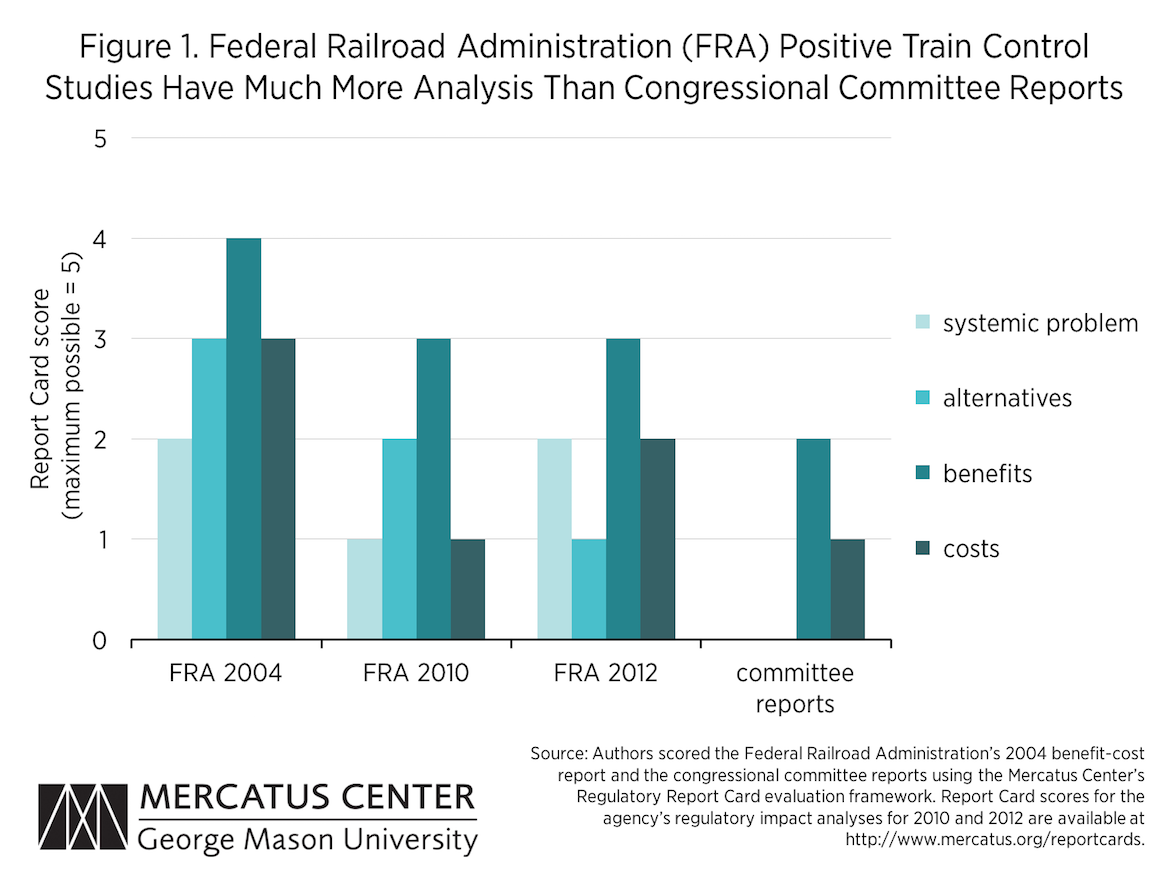- | Academic & Student Programs Academic & Student Programs
- | Regulation Regulation
- | Working Papers Working Papers
- |
Preventing a Regulatory Train Wreck: Mandated Regulation and the Cautionary Tale of Positive Train Control
If Congress insists on writing regulatory mandates into statutes, it should have an organized process for obtaining critical information before decisions are made.
Before they issue new rules with significant economic or societal impacts, regulatory agencies are required to conduct a regulatory impact analysis identifying the systemic problem that the rule seeks to correct, evaluating alternative solutions to the proposed rule, and estimating the benefits and costs of the proposed rule and of alternatives. Congress, on the other hand, is under no obligation to conduct such analysis when it passes laws requiring agencies to enact significant regulations. Between 2008 and 2013, Congress mandated nearly half of all prescriptive, economically significant regulations that were promulgated by regulatory agencies. These congressional mandates, often passed without the benefit of impact analysis, can tie agencies’ hands by requiring them to adopt rules that are not supported by their own analysis.
A new study for the Mercatus Center at George Mason University uses the recent example of the positive train control (PTC) mandate to examine why Congress could benefit from more thorough impact analyses of regulatory legislation. Congress imposed the mandate in response to several high-profile train accidents. The committees that wrote the legislation did not seriously consider the extent of the problem, evaluate alternative methods of improving rail safety, or compare benefits with costs. An appropriations conference committee report required the Federal Railroad Administration (FRA) to produce a study on the benefits and costs of PTC in 2004, but the study appears to have been ignored in the hearings and congressional committee reports accompanying the Rail Safety Improvement Act of 2008 (RSIA). Although the FRA found that the costs of PTC far outweigh any safety benefits, the FRA had no choice but to implement the regulation. Congress could avoid such quandaries by conducting legislative impact analyses before imposing regulations through legislation.
BACKGROUND
In response to several high-profile train accidents, Congress passed the Rail Safety Improvement Act in 2008. This law mandated that the FRA adopt a rule requiring implementation of PTC by 2015. The FRA issued the PTC mandate in 2010 and issued a revised rule in 2012. The FRA, Government Accountability Office, and railroads repeatedly warned that many railroads would not be able to meet this deadline. In 2015, lawmakers extended the PTC installation deadline to 2018 and allowed railroads to request an additional two years to test the systems.
KEY FINDINGS
Complete analysis of a proposed regulation’s impact requires identifying how the proposed rule will solve a systemic problem, assessing potential alternatives, and estimating the benefits and costs of a rule. The Mercatus Center’s Regulatory Report Card provides a framework for comparing the quality of the FRA’s analyses of PTC, both before and after passage of the RSIA, with Congress’s analysis. Figure 1 shows how the FRA studies and congressional committee reports on the RSIA compare on the Report Card scoring system for the four major elements of regulatory impact analysis.
Congressional hearings and reports on the RSIA contain very little analysis of the PTC mandate it forced on the FRA.
- The congressional committee reports contained no substantial analysis identifying the cause of the safety problem or evaluating the effectiveness of alternative solutions.
- The reports identified the intended safety benefits: reduced accidents, fatalities, and injuries. But the sole estimate of PTC’s effectiveness in the committee reports was an assertion that the National Transportation Safety Board estimated PTC could prevent approximately 40 to 60 accidents that could otherwise result in 7 fatalities and 55 injuries each year. However, the report does not cite a source for these figures, and they were not mentioned in testimony, so it is not clear where the figures came from.
- Cost analysis consisted of mentioning one cost estimate from railroads and a single sentence from a Congressional Budget Office analysis, stating that PTC would cost “at least a few billion dollars.” The FRA’s acting administrator mentioned the agency’s 2004 benefit-cost study in testimony before Congress, but the study was not discussed during the hearings and was not mentioned in the committee reports on the legislation.
CONCLUSION
Fully 49 percent of prescriptive, economically significant regulations proposed from 2008 through 2013 were required by statute. The passage of the PTC mandate illustrates the haphazard approach Congress takes toward requiring the adoption of particular regulations. Although an appropriations subcommittee instructed the FRA to produce a report on the potential benefits and costs of a PTC mandate, the committees that wrote the legislation apparently ignored the report. Congressional hearings and reports are unlikely to generate the analysis necessary to determine the full impact of a proposed regulation. If Congress insists on writing regulatory mandates into statutes, it should have an organized process for obtaining critical information before decisions are made.
To speak with a scholar or learn more on this topic, visit our contact page.


